Intel Core 2 CULV Roundup: Who Needs Atom?
by Jarred Walton on February 4, 2010 4:00 AM ESTBlending Battery Life with Performance
We just showed how CULV skunks Atom when it comes to performance. Dual-core Atom 330 is still quite a bit slower, and it's not even close when we look at the mobile Atom CPUs. This is all from a relatively "weak" 1.3GHz Core 2 processor. But Atom CPUs have a TDP of just 2.5W for N280 and 5.5W for N450 (the latter also includes the chipset, so it actually uses less power than N280 + 945GSE); meanwhile, CULV is listed as having a TDP of 10W. Advantage: Atom, right? Well, not so fast. The newer Pine Trail platform definitely helps, with a much lower power draw from the chipset and graphics. Max TDP doesn't necessarily correlate well to idle or low use TDP, though, which is where most users tend to operate their PCs. Here's how battery life stacks up.
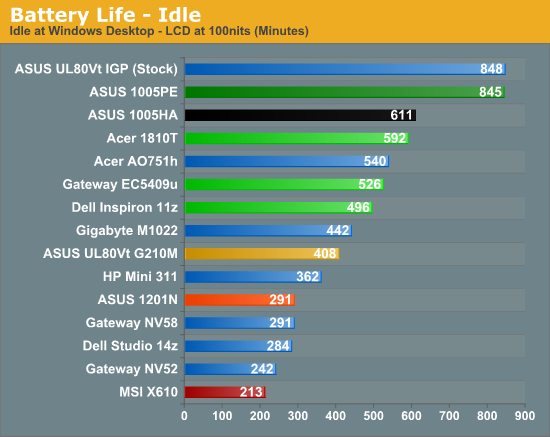
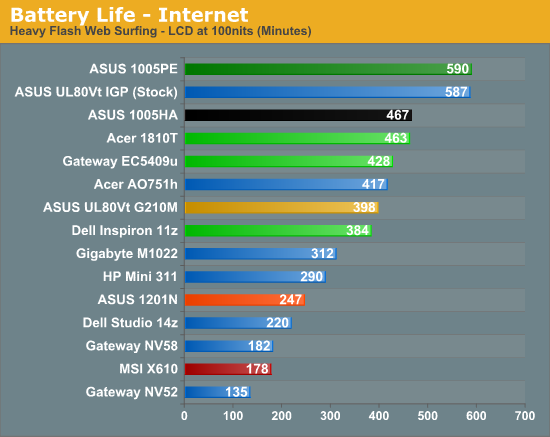
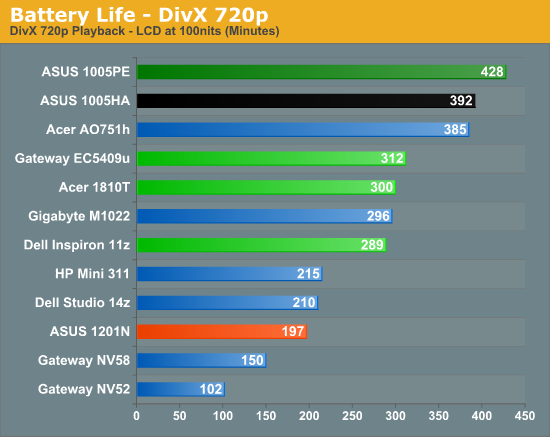
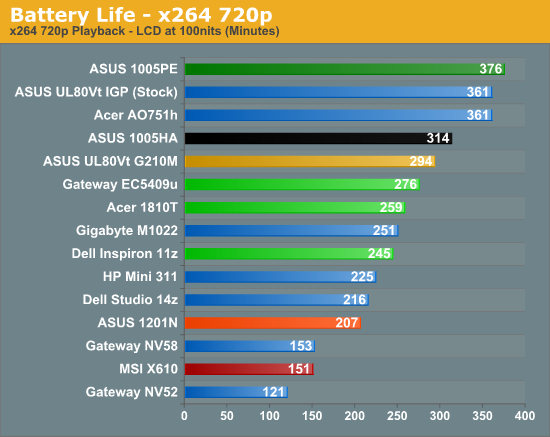
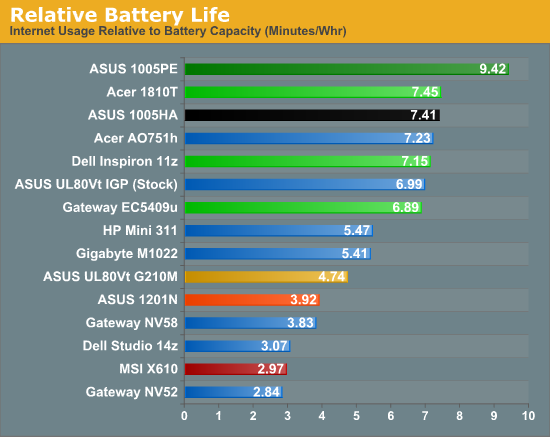
We gained performance but we do give up a bit in battery life - at least when we look at Pine Trail. The smaller CULV laptops like the Acer AS1810T are able to come very close to Atom N280 battery life in the Idle and Internet tests, while the video playback results still favor N280 (provided you're not trying to do 1080p H.264). Atom N450 on the other hand manages to boost battery life by anywhere from 10% (DivX) to 40% (Idle), putting it out of reach of CULV when both are using similar capacity batteries.
The AS1810T delivers an impressive result in our Heavy Internet Browsing test, coming in just shy of eight hours at 463 minutes. That's a virtual tie with the older Atom N280 based ASUS 1005HA (467 minutes), indicating CULV is able to render the web pages and get to a deep sleep state faster than N280. The newer ASUS 1005PE Pine Trail netbook still bests the AS1810T by just over two hours (590 minutes), so if you want maximum battery life Atom continues to beat the other Intel processors. The other CULV options both trail the AS1810T, which is expected. The EC5409u is larger and so the LCD will draw more power, while the Dell 11z has a slightly lower capacity battery.
In terms of relative battery life (and of course, we should note that we're going off the advertised battery capacities, which may be slightly off), the CULV and most N280 offerings are clustered tightly together. While the EC5409u does use more power, the DDR3 memory appears to mitigate that somewhat, with overall battery life still very close to the smaller laptops. Pine Trail is at its best in Idle battery life, but the Internet test is another strong point: it gets 25% more battery life compared to CULV for the same battery capacity.
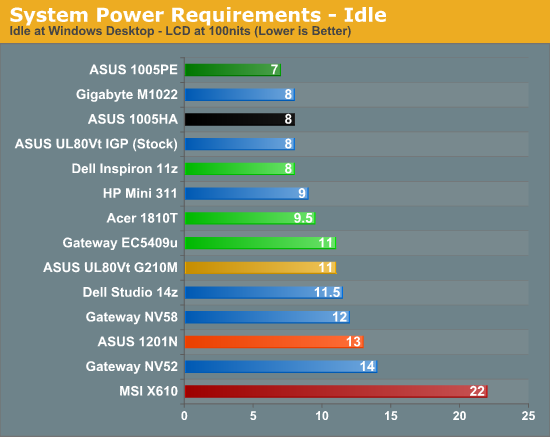
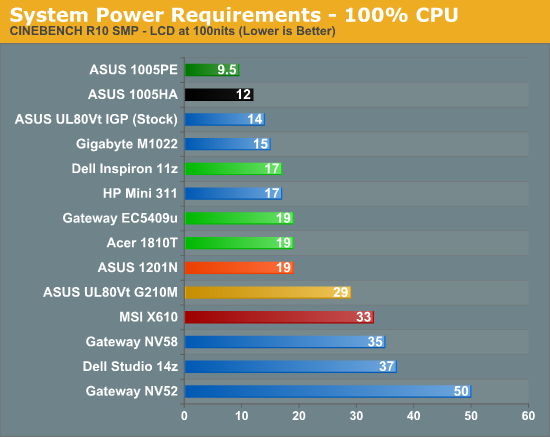
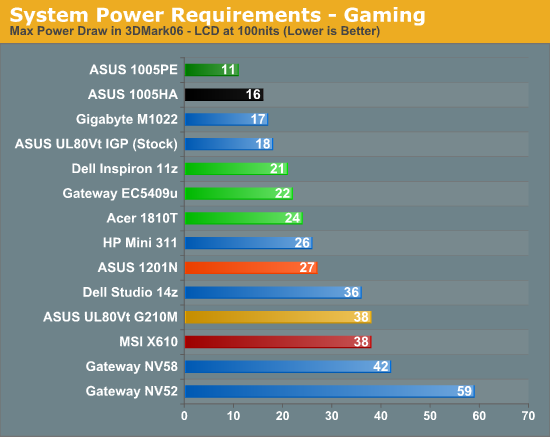
Looking at power requirements helps clear up any lingering questions. Mobile Atom CPUs are designed to sip power, with their highest load sucking down around 4W for N450 and 7W for N280 (including chipset power draw). We estimate that at idle, Atom N280 uses 1W, the chipset probably uses 2W, LCD gets 3W, and the remainder is divvied up among the other bits and pieces. Atom N450 can cut another 1W from Idle power requirements, which is at least a 15% reduction (and possibly more, given our tools are only accurate to at best .5W). In contrast, a CULV CPU can idle very well, but under load the power draw jumps significantly. The AS1810T looks like it uses every bit of its 10W max TDP. Add on graphics and the gap widens even more, though here we need to mention that GMA 950/3150 are a very big step down from GMA 4500MHD (which is another big step back from something like GeForce 9400M).
Overall, it appears that CULV processors are very similar in terms of idle power requirements when compared to Atom N280, especially once we factor in chipsets. As we mentioned above, in many situations an application will need to do a set amount of work as quickly as possible (e.g. rendering a web page), after which the CPU can go into a deep sleep state. The faster the work gets done, the sooner the CPU can sleep, and the net result is that even in moderate loads CULV can compete quite well against N280. The catch is that there are other loads (like video decoding) where CULV ends up using quite a bit more power than Atom, but in common usage scenarios the battery life is still very good.










62 Comments
View All Comments
JarredWalton - Friday, February 5, 2010 - link
There's not a ton of flex - nowhere near as bad as some older MSI laptops, for example - but it does have a bit of spring and it's a "soft touch" keyboard, which just feels mushy to me. I prefer a bit more click, and the spacing and shape of the keys on the 1810 wasn't as nice as the 11z. But, that's a lot of personal preference so if you like the 1810 keyboard there's nothing else I'd complain about with the design.OCedHrt - Thursday, February 4, 2010 - link
Maybe it is just me, but the graphs would be a lot clear if the processors were listed out.I assume the power draw graphs at the end of the battery page is based on the run time and battery capacity?
JarredWalton - Thursday, February 4, 2010 - link
Power graphs are based on power draw from the outlet, at 100nits LCD brightness, with all power saving features enabled (balanced power profile).Adding the CPU to each line compresses the graphs in a way I don't like. Just to quickly list the various CPUs:
Acer AO751h = Atom Z520
Acer AS1810T = Core 2 Duo SU7300
ASUS 1201N = Atom 330
ASUS 1005HA = Atom N280
ASUS UL80Vt = SU7300 (dark gold = OCed to 1.73GHz)
Dell Inspiron 11z = Pentium SU4100
Dell Studio 14z = P8600
Gateway EC5409u = Pentium SU4100
Gateway NV58 = Pentium T4300
Gateway NV52 = Athlon X2 QL-64
Gigabyte M1022 = Atom N280
HP Mini 311 = ION with Atom N280
MSI X610 = Athlon MV-40
Ralos - Friday, February 5, 2010 - link
The title of the article suggest this is a CULV vs Atom showdown. When I look at the graphics, I don't see this, I see a bunch of Acer vs Asus vs HP vs Dell and from what I gather, performance seems to be similar whatever brand the same CPU is sold with, so it really should show the name/speed of the CPUs in there.JarredWalton - Friday, February 5, 2010 - link
Per request, I've updated the chart colors to highlight other important systems. Atom 330 (ASUS 1201N) is orange, MSI X610 (Athlon MV-40 with HD 4330) is red, ASUS 1005PE (Atom N450 Pine Trail) is dark green, and ASUS 1005HA (Atom N280 Diamondville) is black. Hopefully that will help read the charts.OCedHrt - Thursday, February 4, 2010 - link
Well, thanks for trying anyways :)I guess my question is where a Z550 would stack up. Its safe to say it's 50% faster than the Z520, but I don't see that laptop in the performance line up.
I'd wager that it's marginally faster than the ASUS 1005HA with less power draw (but how much less?).
Basically, I'm trying to figure out what is the possibility of a CULV Sony X laptop in the near future ;) It may be unlikely simply due to die size..
JarredWalton - Thursday, February 4, 2010 - link
I think Z550 gets paired up with the GMA 500 chipset, which is good for HD video decode but I'm not sure that it's actually worth using. I know Linux users don't like it because it's a new proprietary GPU with no driver support.My experience (which is limited to the Acer 751h) was that it frequently crashed; what I don't know is if that was the chipset, or just a poor sample laptop from Acer. I also know that I've heard from a few readers saying they have one that crashes all the time as well. Hopefully it's the 751h and not the chipset.
As far as power draw, it should be about the same as the other Atom laptops - probably more than the 751h and 1005HA, given the 2.0GHz clock. Even then, look at the two N280 units (ASUS 1005HA and Gigabyte M1022) and you can see that not all netbooks are created equal. The Gigabyte seems to be a poor example of a netbook, though, with much worse battery life than the competition.
At 2.0GHz Atom Z550 will still be much slower than any CULV, so I'd recommend sticking with CULV unless the pricing is very compelling.
OCedHrt - Thursday, February 4, 2010 - link
The Z550 actually has a slightly lower (0.1) TDP than the N280. It's not the pricing that's compelling, but the form factor: 1.6 lb 11.1" 10.95"(W) x 0.55"(H) x 7.29"(D)KaarlisK - Friday, February 5, 2010 - link
Power consumption should be lower - the TDP of the entire Poulsbo chipset is only 2.3W. However... the damn GMA 500 is HORRIBLY slow. Even for Aero. And Intel still hasn't (and probably won't) released WDDM1.1/DX10 drivers, even though the hardware supports it. Also, the driver doesn't support 8bpp color at all.OCedHrt - Friday, February 5, 2010 - link
Best bet is probably to not run windows on this one ^^I really wish there was a CULV option, even a core solo would be much better.
I saw in some forum that they got OS X running on it. *shudder*